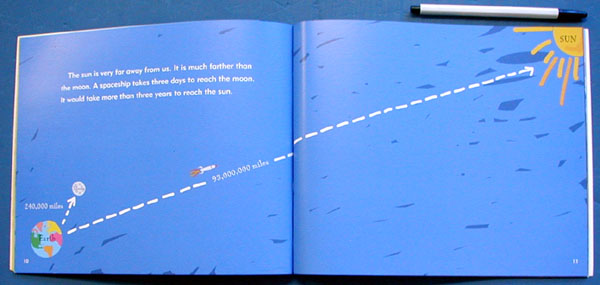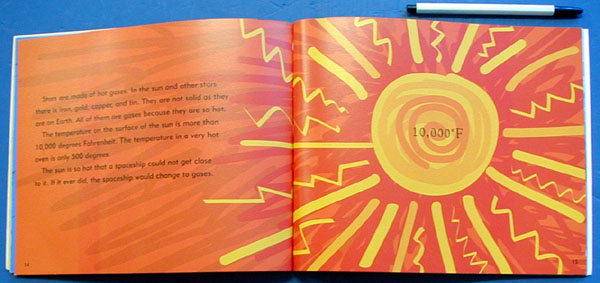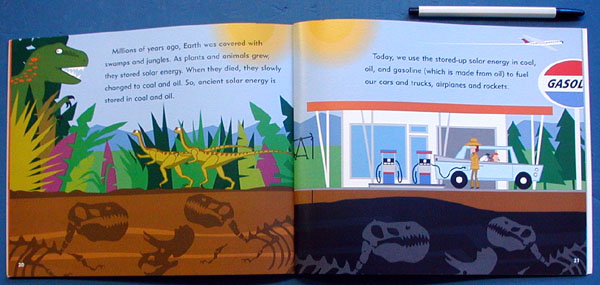|
|
|
|
 |
 이전 | 이전 |  목록 | 다음 목록 | 다음 |
|
확대 이미지 : 상세그림 1

|
확대 이미지 : 상세그림 2

|
확대 이미지 : 상세그림 3

|
[ 책 소개 ]
Harper Collins의 Let's-Read-and-Find-Out Science시리즈는 과학의 기본개념을 알기 쉽게 소개하며 어린 아이들의 과학, 기술, 자연에 관한 다양한 호기심과 궁금증을 해결해 줄 수 있는 우수한 어린이 과학도서입니다.
태양은 지구를 따뜻하게 하며 에너지를 줍니다. 태양이 없다면 지구는 아마 캄캄해지고 차가와져서 동물이나 식물이 살 수 없는 곳이 될 것입니다. 태양의 성분이 어떻게 열을 발생시키며 크기는 얼마나 크며 지구에서 얼마나 멀리 떨어져 있는 지 등의 과학적인 정보들을 알려줍니다.
[ 서지 정보 ]
Edition: Paperback: 32 pages
ISBN: 0064452026
책 크기: 25cm x 20cm
[ 영문 서평 ]
Annotation
Describes the sun and how it provides the light and energy which allow plant and animal life to exist on the earth.
From the Publisher
The sun brings heat, warmth, and energy to the Earth.
What is the sun made of? How big is it? How far away? Read and find out!
Children's Literature
Young readers can learn about what the sun is and why it is important to us in this colorful book. It explains that our sun is a daytime star and is much bigger than Earth and much farther away than the moon. The composition and heat of the sun are described on a bright page of golds, oranges, and reds while the fate of the Earth without the sun is on a dark page of blacks, grays and silvers. The reader learns that the sun, or solar energy, keeps us alive and that ancient solar energy stored in coal and oil is the fuel we use for cars, trucks, airplanes and rockets. The book ends with two easy and interesting projects. One proves to a child that plants need sunlight and the other shows how the Earth moves around the sun and casts shadows that can be used to tell time. This is a Stage 2 book in the publisher's "Let's-Read-And-Find-Out Science" series. 2002 (orig. 1961), Harper Collins Children's Books, - Janet Crane Barley
School Library Journal
K-Gr 2 This new edition features lively and inviting illustrations by Madden. Unfortunately, the drawings take some poetic license and portray the sun spewing out what look like flames. Since the sun isn't on fire there isn't enough oxygen this is misleading to young readers. This one error is more than compensated for by Branley's enthusiastic description of our sun. Sprinkled throughout the text are lots of gee-whiz facts to keep children interested. In addition, a simple experiment, showing the importance of light on plant growth, demonstrates the connections between life on Earth and our sun. There is even a mention of solar energy. Alan Newman, Johns Hopkins University, Baltimore
School Library Journal
Gr 1-2-The third edition of this title pairs bright, computer-produced cartoon art with a basic discussion of the sun and its importance to life on this planet. The pictures and text work closely together to impart such information as how large, hot, and distant the sun is, and how its energy is stored, not only in the foods we eat, but also in the fossil fuels we use. However, as Branley concludes with a particularly poorly thought out sundial project, and neglects to recommend books or Web sites, or to warn readers about the dangers of gazing directly at the sun, Paulette Bourgeois's The Sun (Kids Can, 1997) and Allison Lassieur's The Sun (Children's, 2000) make preferable replacements for the older edition (1988).-John Peters, New York Public Library Copyright 2002 Cahners Business Information.
Booklist
K-Gr.2. This edition marks the third incarnation of an old standby from the Let's-Read-and-Find-Out Science series. The gently edited text reads better than the old one. The new design features a larger format, bolder typography, and eye-catching artwork. In the stylized illustrations, created using digital software, Miller distills figures down to their essential forms and creates pleasing compositions that range from a dark, cold world without a sun, to a close-up picture of the sun that seems to blaze from the page. A handsome new edition of a library staple. Carolyn Phelan
|
| * 작가의 다른 작품(3) |
The Moon Seems to Change - Let's-Read-And-Find-Out Science. Stage 2, 슈퍼바이
The Moon Seems to Change
Let's-Read-And-Find-Out Science. Stage 2, 슈퍼바이 | The Sky Is Full of Stars - Let's-Read-and-Find-Out Science. Stage 2, 슈퍼바이
The Sky Is Full of Stars
Let's-Read-and-Find-Out Science. Stage 2, 슈퍼바이 | Down Comes the Rain - Let's-Read-and-Find-Out Science, 2단계
Down Comes the Rain
Let's-Read-and-Find-Out Science, 2단계 |
| * 최근 이 작품을 구입하신 분들의 다른 선택 |
Weather Forecasting
Gail Gibbons 그림과학책, 페이퍼백, 슈퍼바이 |
The Berenstain Bears Christmas Treasury
스토리북 그림책 4권 합본책, 하드커버, 슈퍼바이 |
Arctic Fox's Journey
Let's Read-And-Find-Out Science. Level 1 |
Clever Beatrice
Charlotte Zolotow Award 수상도서, 페이퍼백, 슈퍼바이 |
|
| |
|
|